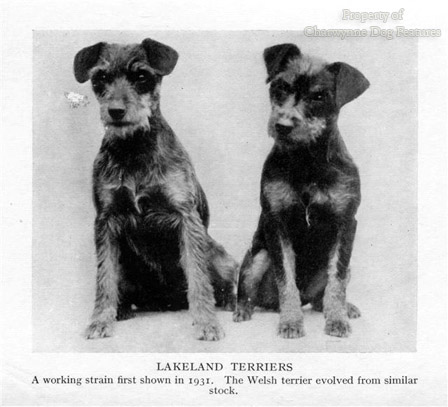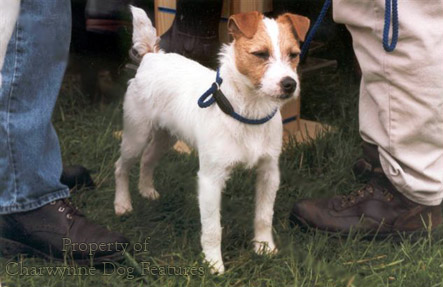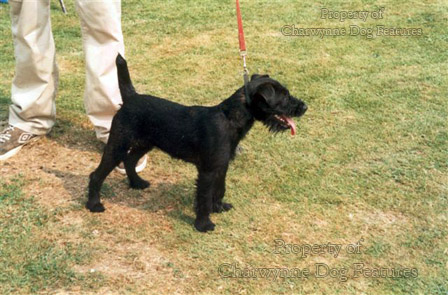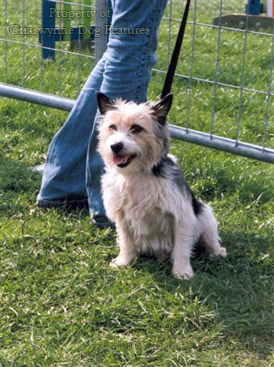238 Build of the Working Terrier
BUILT FOR WORK -- OR JUST FOR SHOWS?
by David Hancock
The Anatomy of Today's Working Terrier by Colonel David Hancock
"First of all make certain that you have the sort of terrier whose build will enable him to do his job effectively and with ease to himself." That quaintly worded but still telling advice was offered sixty years ago by the field sports enthusiast and working terrier devotee, Major G.B.Ollivant. But what build does enable the earthdog to do his job not only well but more easily? Mr. O.T.Price, that much-loved old terrierman, who sustained his own type of terrier from 1896 to the 1950s, opted for a dog "Twelve inches in height, about three and a half in breadth and weighing about twelve pounds." "I like a narrow eel-like terrier" he used to counsel. Certainly his favourite dogs 'Tartar' and 'Worry' and his little bitch 'Twinkle', famed over many counties, were on these lines.
Geoffrey Sparrow, in his classic 'The Terrier's Vocation', goes for a dog "...weighing from twelve to sixteen pounds, with a strong jaw -- not snipey like the show breeds -- a good back, neck and shoulders, and fairly long legs. The length doesn't matter. They can be folded up while bad shoulders cannot." He would not have liked the foxterriers in contemporary Kennel Club show rings, with their upright shoulders and anteater muzzles. If they could actually get underground, they are unlikely to re-emerge!
But I'll go back to Major Ollivant for a most interesting description of the physique of his terriers: "The conformation I have always found the best for a Working or Hunt Terrier is that which approaches the nearest in build to the short-backed short-legged hunter...like the short-legged hunter he must have long, well laid back, sloping shoulders, a short back and big long galloping quarters. This conformation will make him stand over a lot of ground, in spite of the fact that his back is short and not long." As he didn't specify proportions, it is arguable what he really meant by the word 'short' in connection with backs. Most wild creatures which live underground have been shaped by nature to have relatively long backs.
Dan Russell, in his admirable 'Working Terriers', states "Fourteen pounds should be the weight to seek for...Length of leg does not matter a great deal. A long-legged dog can get down a surprisingly small hole if he is narrow chested...The dog to refuse instantly is the one with loaded shoulders or turned-out elbows or a wide cobby chest." In the same vein, William Baker, one of the breeders who developed the Sealyham, has put on record: "In my opinion, no Terrier for underground work should be coarse in his shoulders, but my experience teaches me that nature decrees that a certain width of chest is always there in the gamest of them. The Sealyham of today is verging on a fancier's craze -- straightness, length of head, great bone and cloddiness. If these are carried to excess, goodbye to him as a working Terrier." Prophetic words!
The use of the expression 'gamest of them' applied to Sealyhams resurrects an old worry of mine. Having read of the method used by the celebrated Captain John Tucker-Edwardes to 'prove gameness' in the terriers he used when fashioning the Sealyham as a distinct breed, it has always appeared to me the perfect recipe for producing brainless canine psychopaths. I cannot understand his fame as a terrierman if the stories about his 'selection tests' are true. Terriers which when not at work are expected to kill captive polecats are not likely to appeal to those terriermen who also keep ferrets!
I am reminded of the story of the half-wit who returned a young terrier to its breeder as a 'waste of space' because it declined to slaughter a neighbour's tomcat which he had put into a barrel with his newly-acquired pup to 'see what it was made of'. The pup, which had been raised with farm cats in his barn birthplace, went on to prove himself as the bravest of dogs. I have never heard a proper terrierman admire a dog that was too hard. O.T.Price once stated: "Don't let your terrier get too hard. Remember that a terrier's job is to bay the fox not fight it." And, according to Dan Russell, "the hard dog is as big a nuisance as the coward. He spends half his working life in hospital."
Major Ollivant wrote that "...the terrier's pluck must not be the bravery of the Bull Terrier that goes in regardless of consequences, but the brave, fearless kind of pluck that knows its own danger, and yet has the grit to stay there." The relevance of degrees of aggression to build lies in the fact that if you use bullterrier blood to strengthen the head, you risk the production of a holy terror that could be a blessed nuisance! When I hear of working terriermen utilising show dog blood to achieve a physical point, I recall the words of Geoffrey Sparrow on this subject: "...but then she had a working pedigree back to the nineties on both sides. The real blood must be there or the pups are sure to throw to soft lines."
The Rev.John Russell's own description of his ideal terrier as manifested in his renowned 'Trump' is worth quoting: "Her colour was white, with just a patch of dark tan over each ear and a similar dot not larger than a penny piece over the root of her tail. The coat, which was thick, close and a trifle wavy, was well calculated to protect the body from the wet and cold. The legs were straight, short and thick, and the feet perfect, while the size was equal to that of a full-grown vixen fox, that is to say, her weight was about twelve pounds. Her whole appearance gave indications of courage, endurance and hardihood."
It is interesting to compare the great man's words with those of the standard first proposed by the PJR Terrier Club. This early official club blueprint stated: "Coat -- rough, a trifle wiry or smooth. Dense with belly and undersides not bare...Forelegs -- strong and straight with joints in correct alignment. Elbows hanging perpendicular to the body, working free of the sides." (I'm not sure I want a dog answering to that description!) There was no indication of what the dog's general appearance should be like; I think I'll stay with the vicar! Any pedigree Parson Jack Russell dog which is less than 13" at the shoulder does not meet the requirements of the official KC breed standard. This means that the best working Jack Russell in the whole country could not win in the KC show ring entirely on grounds of size. Is that the best way to judge sporting terriers? 
I'm not surprised to read the judge's critique at a recent National Terrier Championship show which states: "I'd hoped to find more of the West Country original Parson types but sadly, there were few who looked like them. We seem to be moving towards a modern day PJRT which wasn't at all what was intended when the club was revived some ten years ago." Another judge at a different show gave this report: "I was disappointed with the quality of my entry, too many had heavy cheeks, absolutely foreign to the Standard." Now there's a valuable yardstick for passing judgement on a breed designed to work! "Tell me, terrierman, what's the problem?" says the MFH. "Sorry, Sir John, but they've all got heavy cheeks -- I think we'll have to cancel." We can all guess at the MFH's response!
At Crufts this year, the Lakeland Terrier judge used these words in his show report: "On the whole the standard of Lakelands at this show were (sic) not of a very high standard, some nice ones, some not so nice, and some absolute rubbish." I do hope those working Lakeland terriermen who resort to show dog blood occasionally choose wisely! The myth of the association between pedigree and quality is surely finally acknowledged by sportsmen of all styles. At the Scottish KC Championship show a year ago, the judge recorded: "When recognition of the PJRT took place I was under the impression that we were going to preserve the look of this old type of working terrier, it now seems that some breeders with no knowledge of, or regard for, the traditional type are determined, with the help of judges with no breed type experience, to change completely the character and look of the breed." That, in comparatively few words, sums up very aptly what happens to terrier breeds in the KC show rings. God protect the Patterdale, the Lucas, the Plummer and any others heading towards KC recognition. Performance is soon second to prettiness.
When judging the build of a working terrier, let's be guided by the wise words of our Major Ollivant: "A terrier that has to work underground must have his heart in the right place; then if his body permits him to do so, he will get there like the good sportsman he is." The only reason why we have working terriers to breed from nowadays is that countrymen who were real terriermen kept their heads over many years and ignored the financial allure of the KC show rings. I salute them.